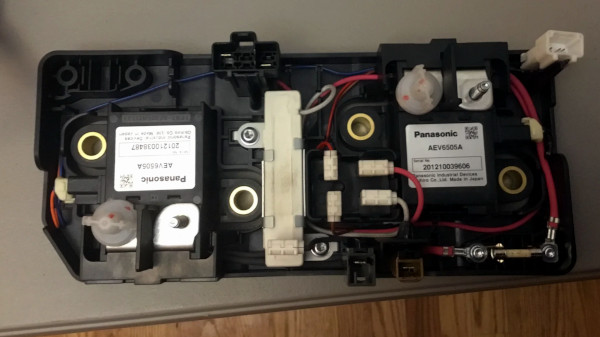
The picture shows a contactor block located inside the Nissan Leaf battery. There are contactors on the left and right, and a ceramic precharge resistor in the center.
How to burn a PreCharge resistor
In the article about an additional battery for the Nissan Leaf, I already wrote about the author of the YouTube video, who connected an external battery to the high-voltage bus of the car (not to the contacts behind the contactors inside the battery, but to the car high-voltage bus). He turned off the car first, and then the battery. As a result, his precharging resistor burned out and the car wouldn't charge anymore.
I've seen other posts on forums. But I don’t know the details of how they burned the resistor.
What is a pre-charge resistor and why does it burn?
In short, a precharging resistor is needed to prevent the contacts and electronics from being burned by high current when switching a high-voltage load. Let's say you have a 400V battery and the rest of the system with a very large capacitance (a large capacitor to smooth out voltage surges). Initially, the system is not under voltage. If you immediately connect the battery to the rest of the system, the battery should charge the capacitor from 0 to 400V almost instantly. In an ideal system, the current will be infinite. In reality, it will be determined by the resistance along the current path (mostly wires).
Just preliminary calculations in order to estimate it:
Let's take the resistance of the wires as 0.01 Ohm (please, correct me if my estimate is far from the truth). At the very moment of switching on, there will be a difference of 400V at the ends of the wire. The current will be 400 V / 0.01 Ohm = 40 thousand amperes. Neither contactors nor semiconductors (if they are in the circuit) can withstand such a current. Even at 0.1 Ohm, the current will be 4,000 A, which is also a lot.
Therefore, in order to prevent the electronics from killing with such a huge current, first, for a split second, the current is supplied through a precharging resistor. Nissan Leaf has a precharge resistor rating of 40W 30 Ohm. Let's do the math. 200 V / 30 Ohm = 6.7 A. And it's very resonable current! In a short time, the capacitor charges. After that the main contacts are closed, but the enormous current no longer flows because the voltages have leveled out.
Here is a video that shows the sequence of signals on the high voltage relay and the relay switching on the precharge resistor: